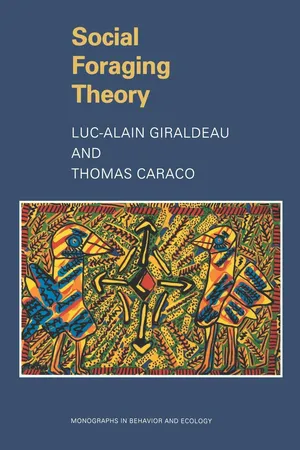
- English
- PDF
- Available on iOS & Android
Social Foraging Theory
About this book
Although there is extensive literature in the field of behavioral ecology that attempts to explain foraging of individuals, social foraging--the ways in which animals search and compete for food in groups--has been relatively neglected. This book redresses that situation by providing both a synthesis of the existing literature and a new theory of social foraging. Giraldeau and Caraco develop models informed by game theory that offer a new framework for analysis. Social Foraging Theory contains the most comprehensive theoretical approach to its subject, coupled with quantitative methods that will underpin future work in the field. The new models and approaches that are outlined here will encourage new research directions and applications.
To date, the analysis of social foraging has lacked unifying themes, clear recognition of the problems inherent in the study of social foraging, and consistent interaction between theory and experiments. This book identifies social foraging as an economic interaction between the actions of individuals and those of other foragers. This interdependence raises complex questions about the size of foraging groups, the diversity of resources used, and the propensity of group members to exploit each other or forage cooperatively. The models developed in the book will allow researchers to test their own approaches and predictions. Many years in development, Social Foraging Theory will interest researchers and graduate students in such areas as behavioral ecology, population ecology, evolutionary biology, and wildlife management.
Frequently asked questions
- Essential is ideal for learners and professionals who enjoy exploring a wide range of subjects. Access the Essential Library with 800,000+ trusted titles and best-sellers across business, personal growth, and the humanities. Includes unlimited reading time and Standard Read Aloud voice.
- Complete: Perfect for advanced learners and researchers needing full, unrestricted access. Unlock 1.4M+ books across hundreds of subjects, including academic and specialized titles. The Complete Plan also includes advanced features like Premium Read Aloud and Research Assistant.
Please note we cannot support devices running on iOS 13 and Android 7 or earlier. Learn more about using the app.
Information
Table of contents
- Cover
- Title Page
- Copyright Page
- Contents
- Preface
- Acknowledgments
- 1 Social Foraging Theory: Definitions,Concepts, and Methods
- PART ONE: Group Membership Games
- PART TWO: Producer-Scrounger Decisions
- PART THREE: Decisions within Patches
- PART FOUR: Models of Phenotypic Diversity
- PART FIVE: Final Thoughts
- References
- Subject Index
- Species Index